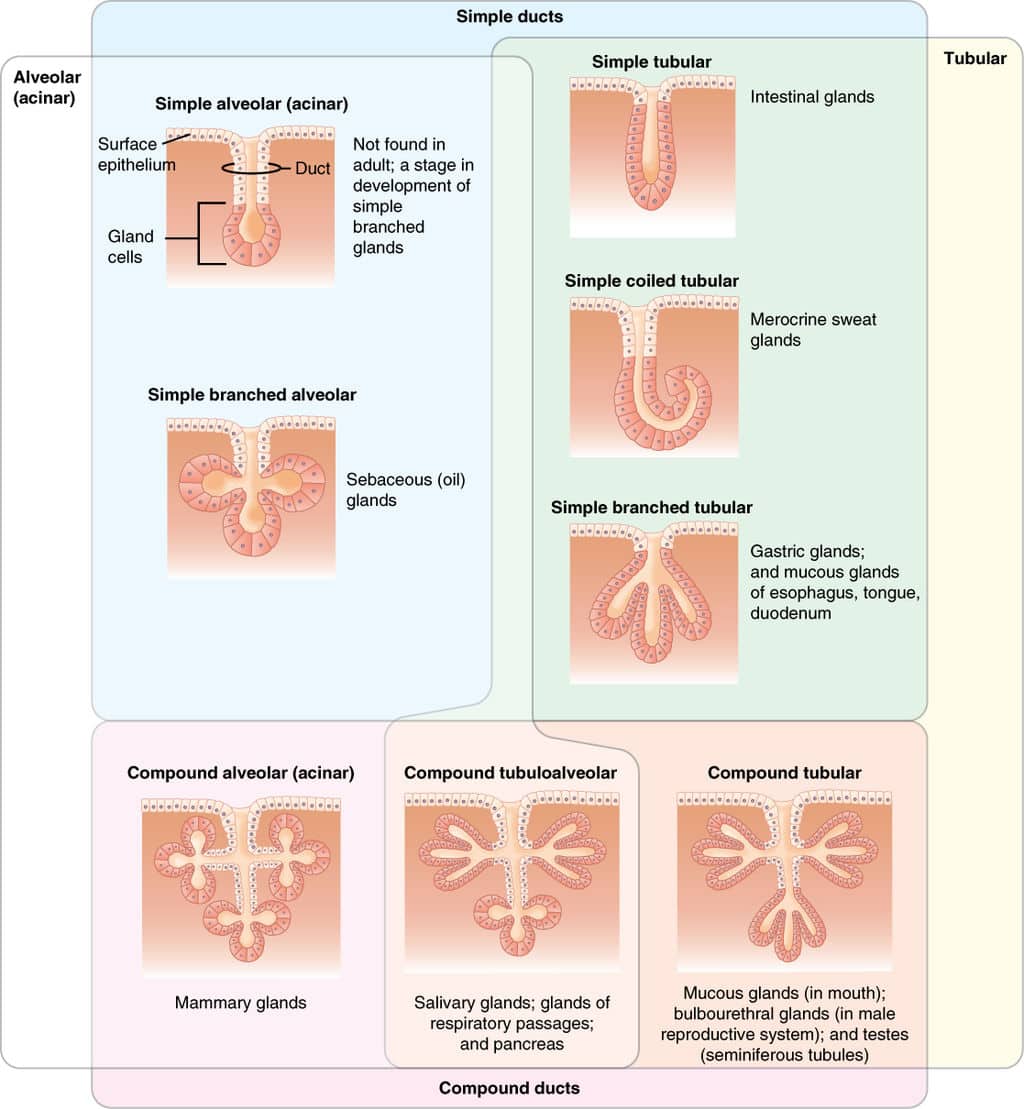Glands are collections of secretory epithelial cells. This article discusses the structure of the two main types of glands (exocrine and endocrine).
Exocrine Glands
Exocrine glands secrete onto a surface and possess ‘ducts’ lined with epithelium; they can either be simple or compound.
- Simple glands – these have a single, unbranched duct. Examples include sebaceous glands, intestinal crypts and uterine glands.
- Compound glands – these have multiple, branched ducts. Examples include the salivary glands and the pancreas.
Exocrine glands are classified by the shape of their secretory unit:
- Tubular glands – these have secretory units that resemble a tube-like shape and are found in the uterus, alimentary tract and sweat glands.
- Acinar (alveolar) glands – these have a more rounded secretory unit and are found in the breast.
Secretory units of both shapes, are referred to as a tubuloacinar or tubuloalveolar gland. They are found in the pancreas and salivary glands.
Exocrine glands can have mucous, serous or mixed secretions; mucous glands secrete a glycoprotein mixture (mucus), serous glands produce a watery fluid containing a variety of enzymes and finally, mixed glands secrete a mixture of both mucous and serous secretions.

Figure 1 – Diagram to show the different types of exocrine gland
Clinical Relevance – Cystic fibrosis
Cystic Fibrosis is an autosomal recessive genetic disorder, where a mutation in the CFTR gene leads to defective chloride channels in the exocrine glands of the body.
Secretions become hyperviscous and causes signs and symptoms such as salty-tasting skin, poor growth, accumulation of thick mucus, coughing and shortness of breath. There is no known cure for Cystic Fibrosis and so treatment is mainly symptomatic management.
Endocrine Glands
Endocrine glands are ductless and release their secretions (hormones) directly into the bloodstream. These form the basis of the endocrine system, which relies heavily on the right level of hormones secreted throughout the body.
Examples of endocrine glands include the pituitary gland, pancreas, adrenal glands, the thyroid gland and parathyroid glands.
Pituitary Gland
The pituitary gland is an important gland of the endocrine system that secretes a number of hormones which target different organs to regulate vital body functions and general wellbeing. It sits below the hypothalamus and consists of the anterior (adenohypophysis) and posterior (neurohypophysis) pituitary.
The anterior pituitary secretes the following hormones:
- Luteinising Hormone (LH) and Follicle Stimulating Hormone (FSH)
- Growth Hormone
- Prolactin
- Thyroid Stimulating Hormone (TSH)
- Adrenocorticotrophic Hormone (ACTH)
The posterior pituitary secretes the following hormones:
- Oxytocin
- Antidiuretic Hormone (ADH)
Pancreas
The pancreas has both endocrine and exocrine functions:
- The endocrine pancreas regulates glucose levels in the body by secreting the hormones glucagon, insulin, somatostatin, gastrin and pancreatic polypeptide.
- The exocrine pancreas secretes an alkaline fluid, containing enzymes (such as trypsinogen and lipase) and bicarbonate ions, into the duodenum through the pancreatic duct.
